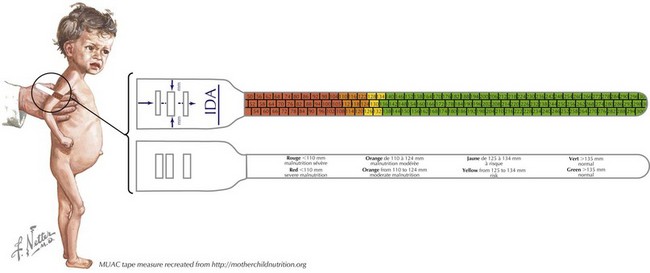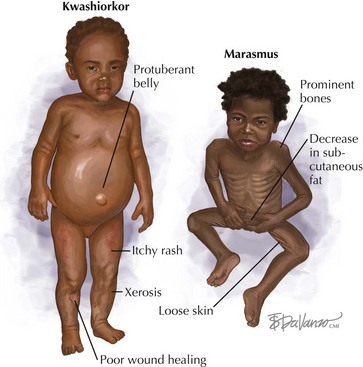14 Malnutrition
Clinical Presentation
Chronic malnutrition is identified by low height for age, also known as stunting. Chronically malnourished children are shorter than other children their age and may fail to meet their long-term growth potential. Acute malnutrition is characterized by low weight for height and low MUAC with or without symmetric edema. Severe acute malnutrition is defined as severe wasting, nutritional edema, or both. An acutely malnourished child has low body fat reserves and may also have limited protein stores. Children with severely low levels of serum protein often develop symmetric edema. Table 14-1 displays criteria used to define moderate and severe malnutrition. This chapter uses the World Health Organization (WHO) definitions to classify the severity of malnutrition. It is common for stunting and wasting to occur concomitantly. Children with combined chronic and acute malnutrition are both short for age and thin for height.
Table 14-1 World Health Organization Criteria for Defining Moderate and Severe Malnutrition
| Moderate Malnutrition | Severe Malnutrition | |
|---|---|---|
| Height for age | −3 to −2 SD below the mean (85th to 89th percentile) | <−3 SD below the mean (<85th percentile) |
| Weight for height | −3 to −2 SD below the mean (70th to 79th percentile) | <−3 SD below the mean (<70th percentile) |
| Symmetric edema | No | Yes |
SD, standard deviation.
Scales for assessing weight, stadiometers for measuring height, and tape measures for evaluating MUAC are all essential tools in settings where severe malnutrition is diagnosed and managed. Growth charts (discussed in Chapter 13) are also necessary to allow for the quantification of the degree of malnutrition. In very low-resource settings when scales are not available, MUAC tapes alone may be used to screen for and follow up severe acute malnutrition (Figure 14-1).
The three common forms of protein-energy malnutrition are marasmus, kwashiorkor, and a mixed form called marasmic kwashiorkor. Whereas marasmus is typically considered to be a reflection of caloric deficiency, kwashiorkor is thought to be reflective primarily of a deficiency of protein. Marasmus can be recognized visually by decreased subcutaneous fat leading to prominent bones and the appearance of “loose skin,” especially around the buttocks. Kwashiorkor is characterized by bilateral pitting edema and a protuberant belly (Figure 14-2). Malnutrition is commonly associated with visible hair and skin changes. The hair is commonly thin, scanty, straight, and lightly pigmented. Skin changes are varied and commonly include xerosis, itchy rashes, and poor wound healing.
Other physical examination findings that are commonly seen with severe malnutrition are outlined in Table 14-2.
Table 14-2 Common Physical Examination Findings in Severe Acute Malnutrition
| Physical Finding | Significance |
|---|---|
| Low height for age | |
| Low weight-for-height and low MUAC | |
| Edema | |
| Extreme pallor | |
| Sunken eyes | |
| Corneal and conjunctival lesions | |
| Weak pulses | |
| Hypothermia | |
| Cold hands and feet without central hypothermia | < div class='tao-gold-member'> Only gold members can continue reading. Log In or Register to continue
Stay updated, free articles. Join our Telegram channel
Full access? Get Clinical Tree
 Get Clinical Tree app for offline access
Get Clinical Tree app for offline access

|

